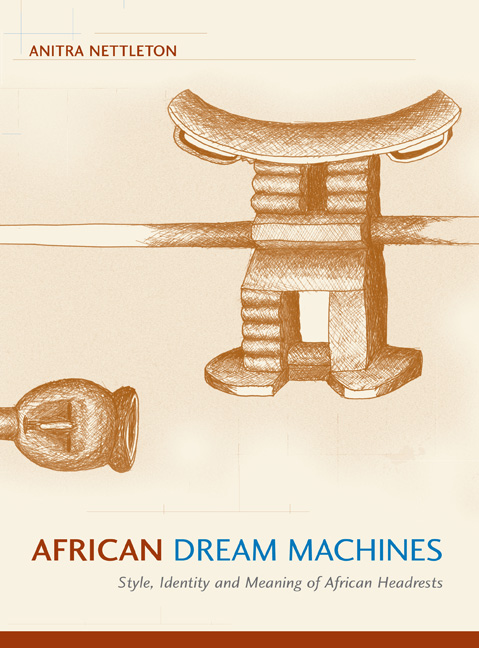Book contents
- Frontmatter
- Contents
- Preface
- Acknowledgements
- Notes on the Use of African Ethnic Names and Country and Place Names
- References to Illustrations in the Text and Notes on Illustrations
- Chapter 1 Headrests and Art
- Chapter 2 A Matter of Style, or, Why Style Matters
- Chapter 3 Methodology, Position and Limitations
- Chapter 4 The Geographical and Chronological Distribution of the Columned Headrest
- Chapter 5 Authenticity and History
- Chapter 6 East African Headrests: Identity, Form and Aesthetics
- Chapter 7 Tracing Histories: Central and Southern African Connections
- Chapter 8 Not Just a Curious Beauty: The Anatomy of Meaning in Useful Objects
- Notes to Chapters
- Bibliography
- List of Illustrations
- Index
Chapter 7 - Tracing Histories: Central and Southern African Connections
Published online by Cambridge University Press: 18 May 2019
- Frontmatter
- Contents
- Preface
- Acknowledgements
- Notes on the Use of African Ethnic Names and Country and Place Names
- References to Illustrations in the Text and Notes on Illustrations
- Chapter 1 Headrests and Art
- Chapter 2 A Matter of Style, or, Why Style Matters
- Chapter 3 Methodology, Position and Limitations
- Chapter 4 The Geographical and Chronological Distribution of the Columned Headrest
- Chapter 5 Authenticity and History
- Chapter 6 East African Headrests: Identity, Form and Aesthetics
- Chapter 7 Tracing Histories: Central and Southern African Connections
- Chapter 8 Not Just a Curious Beauty: The Anatomy of Meaning in Useful Objects
- Notes to Chapters
- Bibliography
- List of Illustrations
- Index
Summary
HISTORY AND THE NOTION OF THE ‘BANTU EXPANSION’
THE MAJORITY OF headrests from Central Africa, especially from the Congo basin and the neighbouring savannah regions to its east, are made with columns, whereas columned headrests are in the minority in south-Central and Southern Africa. Yet both headrests with columns and those with other supports are made and used by speakers of Bantu languages that are related to one other. The idea that Bantu languages spread across Africa from the Niger–Benue area approximately 2,000 years ago seems to be accepted among most historians, anthropologists, linguists and archaeologists, and, although the details of this history are debated endlessly, it appears that shared languages point to some kind of shared origins. The politics of these origins, however, leads into quagmires when applied to cultural studies, and any attempt to link particular headrest types to particular branches of Bantu languages is doomed to failure, partly because the making of headrests is neither universal nor even ubiquitous among Bantu speakers, and because specific headrest types are often not peculiarly made by speakers of one branch of the language. The idea that specific cultural forms belong to speakers of one particular language, or group of languages, or branch of an ur-language (in this case, Bantu) is possibly appropriate to archaeological domains, but it does not have much relevance in more recent history, where types and styles of headrests have surfaced in widely spaced locations, as evidenced in the case of the headrests with columns. Yet the possibility of the existence of an African commonality in cultural forms, which we might hope to derive from such a study of African objects, or indeed from African systems of thought such as that evidenced by divination (Peek 2000), is seriously diluted by a realisation that some Zulu headrests appear to be formally much closer to headrests from the peoples of Tonga in the Pacific Ocean than they are to those of the Tsonga of Mozambique.
I have established a limited number of structural types among the headrests examined in this chapter, but within these structural types there is even more variation than was found in the columned types, or in the East African forms already discussed.
- Type
- Chapter
- Information
- African Dream MachinesStyle, Identity and Meaning of African Headrests, pp. 245 - 340Publisher: Wits University PressPrint publication year: 2007



